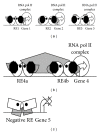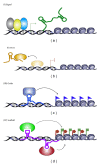Combinatorial control of gene expression
- PMID: 24069600
- PMCID: PMC3771257
- DOI: 10.1155/2013/407263
Combinatorial control of gene expression
Abstract
The complexity and diversity of eukaryotic organisms are a feat of nature's engineering. Pulling the strings of such an intricate machinery requires an even more masterful and crafty approach. Only the number and type of responses that they generate exceed the staggering proportions of environmental signals perceived and processed by eukaryotes. Hence, at first glance, the cell's sparse stockpile of controlling factors does not seem remotely adequate to carry out this response. The question as to how eukaryotes sense and respond to environmental cues has no single answer. It is an amalgamation, an interplay between several processes, pathways, and factors-a combinatorial control. A short description of some of the most important elements that operate this entire conglomerate is given in this paper.
Figures





References
-
- Maston GA, Evans SK, Green MR. Transcriptional regulatory elements in the human genome. Annual Review of Genomics and Human Genetics. 2006;7:29–59. - PubMed
-
- Steinfeld I. The influence of chromatin modifiers on transcription [Doctoral dissertation] Faculty of Life Sciences, Tel Aviv University; 2007.
-
- Phillips T. Small non-coding RNA and gene expression. Nature Education. 2008;1(1)
-
- Venter JC, Adams MD, Myers EW, Li PW, Mural RJ. The sequence of the human genome. Science. 2001;291:1304–1351. - PubMed
Publication types
MeSH terms
Substances
LinkOut - more resources
Full Text Sources
Other Literature Sources

